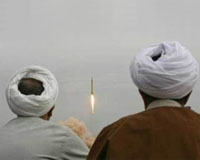| . |  |
. |
Washington (UPI) Mar 17, 2009 Israel has spent years prioritizing its ambitious Iron Dome interceptor program to shoot down very-short-range rockets that bombard towns and settlements within range of the Hamas stronghold of Gaza. Yet Iron Dome will not be near deployment until the middle of next year at the very earliest, if then. And there are grave questions about using an anti-ballistic missile interceptor system, each of whose super-fast rockets costs 10 to 50 times as much as the extremely cheap, low-tech Qassam rockets they are meant to intercept. Yet the development of U.S. defense systems against very-short-range missile attack suggests that when tactical missiles are fired at close range, the best U.S. weapon to shoot them down may be a good old-fashioned machine gun. Except there is nothing old-fashioned about Raytheon's Mark 15 Phalanx Close-In Weapons System, or CIWS: It is already the BMD weapon of last resort of the U.S. Navy and has been increasingly used by the U.S. Army in Iraq. Interest in the Phalanx CIWS stirred in Israel in fall 2006 following the massive Katyusha rocket mortar bombardment of northern Israel by Hezbollah in its brief conflict in July that year. The Katyusha attacks followed an escalating series of less intense and formidable, but still potentially dangerous, attacks against Israel by relatively low-tech, very-short-range Qassam missiles fired by Hamas and its allies from within Gaza, which Israeli forces evacuated in summer 2005. The Israeli army made a massive three-week incursion into Gaza in January this year but failed to seriously attempt to topple Hamas, and as soon as the army left, the rhythm of Qassam bombardments started again. The Israeli military establishment, spearheaded by Defense Minister Ehud Barak and Chief of Staff Lt. Gen. Gabi Ashkenazi, continues to bet big on the technologically pioneering Iron Dome concept. The Phalanx, however, has several striking advantages over Iron Dome. First, it is already operational and being produced and deployed in relatively large numbers. Second, it is the outgrowth of an already mature technology. Super-powerful, ultra-high-speed machine guns have been a key element of the U.S. armed forces for decades. The awesome Gatling gun was used to devastating operational effect in Vietnam. The radar-guided, rapid-firing Phalanx CIWS is a worthy successor to the Gatling. Defense Industry Daily noted in a late 2006 report that it can "fire between 3,000-4,500 20mm rounds per minute, either autonomously or under manual command, as a last-ditch defense against incoming missiles and other targets." "Phalanx uses closed-loop spotting with advanced radar and computer technology to locate, identify and direct a stream of armor piercing projectiles to the target," DID said. Defense Industry Daily noted that two and a half years ago the Phalanx CIWS was already installed "on approximately 187 U.S. Navy ships and is in use in 20 foreign navies." Third, the Phalanx CIWS is vastly more flexible than the ambitious and promising, but still experimental Northrop Grumman Skyguard/Nautilus THEL laser systems. Whatever their other differences, the U.S. armed forces and the Israeli Defense Ministry have exhibited a shared reluctance to push ahead with Skyguard/Nautilus/THEL. (Part 3: What makes the Phalanx a cost-effective BMD system)
Share This Article With Planet Earth
Related Links Learn about missile defense at SpaceWar.com Learn about nuclear weapons doctrine and defense at SpaceWar.com All about missiles at SpaceWar.com Learn about the Superpowers of the 21st Century at SpaceWar.com
 Iran edges ahead in intelligence war
Iran edges ahead in intelligence warBeirut, Lebanon (UPI) Mar 17, 2009 The secret intelligence war between Iran and its allies Hezbollah and Hamas on one side and the United States and Israel on the other is likely to heat up in the months ahead. Right now, Iran's intelligence apparatus seems to be ahead with the Feb. 23 capture of one of the country's most wanted fugitives, Abdulmalik Rigi, leader of a Sunni militant group called Jundallah, or Soldiers of ... read more |
|
| The content herein, unless otherwise known to be public domain, are Copyright 1995-2010 - SpaceDaily. AFP and UPI Wire Stories are copyright Agence France-Presse and United Press International. ESA Portal Reports are copyright European Space Agency. All NASA sourced material is public domain. Additional copyrights may apply in whole or part to other bona fide parties. Advertising does not imply endorsement,agreement or approval of any opinions, statements or information provided by SpaceDaily on any Web page published or hosted by SpaceDaily. Privacy Statement |